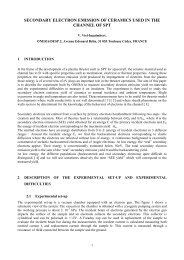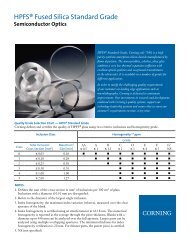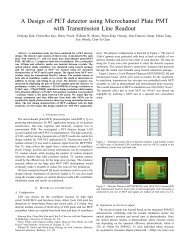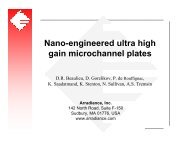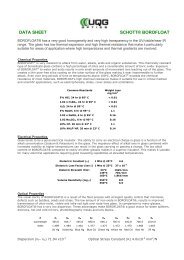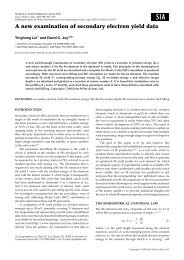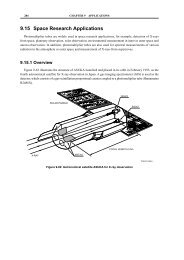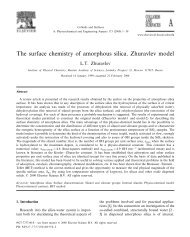You also want an ePaper? Increase the reach of your titles
YUMPU automatically turns print PDFs into web optimized ePapers that Google loves.
2007 <strong>IEEE</strong> Nuclear Science Symposium Conference Record N06-1High Gain Photodetectors formed byNano/Micromachining and NanofabricationDavid R Winn, Member, <strong>IEEE</strong>Abstract– Recently available methods in highly anisotropicnano/micromachining and nanofabrication (N/MEMS) enable thefabrication of high gain photodetector structures in both vacuumand semiconductor optoelectronics. We show results onnanomachined microchannels formed in semiconductors whichenable robust long life photomultiplier-like tubes scaling indiameters from less than 1 mm to 30 cm in diameter, in variousshapes (like strips or hexagons) with very compact dimensionsalong the axis, well less than 1 cm in thickness. The gain lifetimeexceeds 1 C per square cm, and the gains can exceed 9,000 pernanomachined channel. The photolithographically precisechannels enable precision imaging. Because the base matrix is apurified semiconductor, very low self-radioactivity counts result,unlike Pb-glass MCP. Additionally, because of the absence oflead, as in lead-glass MCP, common vacuum photocathodes canbe deposited directly on the throats of the microchannels. Wealso show deposition on the throats of the the microchannels B-doped diamond with a SE yield exceeding 100, for photoncounting. We also discuss results on a photodetector using amethod akin to field emission into silicon, giving an APD-likegain using the geometric shape of the electrodes rather thandoping profiles to achieve a controllable high field avalanchegainregion, with a considerably lower noise than compensateddoped APD, also as a result of a high field volume, the majornoise source, reduced by about 1000 times compared toequivalent APD. This gain has been tested in single pixel formatsusing AFM tips as the basis for the detector, and exceeded 5,000in Geiger mode. These high gain pixel-sized detectors can beformed into imaging chips or silicon-PMT-like gained pixel arraydevices. We discuss applications in a wide variety of scientificinstrumentation.I. INTRODUCTIONPhotomultiplier tubes (PMT) are used in a wide variety ofhigh energy detectors, including scintillating fiber arrays,calorimeters, Cerenkov and RICH counters, triggercounters, beam monitors and others. PMT have changedslowly in the last decades, as have glass-based MCP-PMTwhich have demonstrated ability to operate in high magneticfields with superior time resolution. Vacuum basedphotomultiplier (PMT) technology represents one of the mostversatile photosensitive devices available. Photomultipliersprovide high sensitivity (single quantum) and ultra-fast highgain response compared to other photosensitive devices.Existing PMT have bandwidths (BW) up to 2 GHz at gains ofManuscript received November 23, 2007.This work was supported in part by the U.S. Department of Energy.D. R. Winn is with Department of Physics, Fairfield University, Fairfield,CT 06824-5195 e-mail: winn@mail.fairfield.edu; Telephone 203.254.400010 5-6 . At lower BW, gains exceeding 10 9 are possible.Photocathodes can have sensitivities covering wavelengthsfrom ~200nm - 1.8 microns. Miniaturization of traditionalphotomultipliers from typical photocathode sizes of ~1 cmdiameters down through sub-mm (down to fiber diameters)sizes represents an evolution of this traditional light detectiontechnology. However, PMT’s are relatively bulky, expensive,often largely hand-assembled vacuum tube devices thathaven’t changed significantly in the last few decades, withminimal flexibility on the volume or shape of the sensitiveregion. Typically the volume exceeds ~(1-2) x D 3 , whereaswe propose a PMT that scales more like
oundaries for tiled arrays, with a boundary as low as1 mm between PMT.- Ruggedizable: The dynode structure and the vacuumstructure ultimately become fully integrated in thisPMT design. The SiMCP, machined from siliconplates, and using thin and thick film deposition ofinsulators and conductors can become structuralelements, and thus do not suffer from vibrationalconstraints which require special PMT for spaceflight,for example.- Single-PE resolution: thin cesiated B-dopeddiamond-coated dynodes show a gain of 25 at 300V,and the Si surfaces of the micromachined dynodesproposed are ideal for this purpose.- Cost Benefits: By using standard silicon Fab &MEMS technologies, much of the “hand-labor” stillused in PMT assemblies is largely eliminated.Miniaturization of photomultiplier technology dramaticallyexpands the realm of applicability, enabling imaging, portableand more compact detector/instrument applications.Additionally, finely pixellated PMT enable fiber readouts andother imaging applications (RICH, and others). On the otherhand, large PMT have a wide variety of applications in lowrate/low cross section experiments in neutrino & astroparticlephysics.III. PROGRESS IN MICROMACHINED SILICON MICROCHANNELPLATES FOR MICROMACHINED PMTMicrochannel plates (MCP) fabricated from standard siliconwafer substrates using a novel silicon micromachiningprocess, together with standard silicon photolithographicprocess steps, have been fabricated iii . The resulting SiMCPmicrochannels have dimensions of ~0.5 μm up to ~25 μm,with aspect ratios up to 300, and have the dimensionalprecision and absence of interstitial defects characteristic ofphotolithographic processing, compatible with positionalmatching to silicon electronics readouts. The open channelareal fraction and detection efficiency may exceed 90% onplates up to 300 mm in diameter. The resulting siliconsubstrates can be converted entirely to amorphous quartz(qMCP) or SiC. The strip resistance and secondary emissionare developed by controlled depositions of thin films, attemperatures up to 1,200°C, also compatible with hightemperturebrazing, and can be essentially hydrogen, waterand radionuclide-free. Novel secondary emitters and cesiatedphotocathodes can be high-temperature deposited or nucleatedin the channels or the first strike surface. Results on resistivity,secondary emission and gain are presented below.Silicon MCP Substrates: Silicon microchannel plates(SiMCP) have been fabricated using a photolithographicallyinitiated proprietary micromachining process developed atNanoSciences Corporation (NSci). The placement, size andpore uniformity of the silicon MCP substrate channelstherefore have dimensional precisions greatly exceeding thatof glass-fiber-based MCP. Figures 1-4 show SEMmicrographs of 4 different forms of these substrates, andFigures 5a-c show optical photographs of the SiMCP. Thecomplete elimination of MCP defects (for example, due tomisplacement or defomation of the glass fibers in a boule) isachievable, and the microchannel outputs can be placed withprecision with respect to potential lithographically patternedreadouts. Pore diameters are fully adjustable between 0.5-25μm, with high aspect ratios (α=hole length/hole diameter) - upto 300:1 has been achieved with 3 μm holes - a possibletheoretical limit is α>2,000:1. Large SiMCP diameters arepossible, up to the size of available silicon wafers - limitedwith presently commercially viable silicon wafers to ~30 cm(12”) diameter SiMCP plates. At present, SiMCP of 10 cmdiameter have been produced, limited only by the installedphotolithographic equipment (4” wafer fab). The holes can besquare, and >90% open area; micromachining can taper thehole entrances as shown in Figure 1. These SiMCP substratescan be vacuum-baked at temperatures ~1,200° C, and brazedat similar elevated temperatures, much hotter than thosepossible with glass MCP, or converted entirely or partially tooxide (amorphous quartz - qMCP) for even higher temperatureprocessing. Chevroning up to 8° to the surface plane havebeen demonstrated, as shown in Fig.4.Fig. 1a,b: Micromachined Silicon Plates for a precision Si MCPPhotomultipliers: The square channels are on a 6 μm spacing, with a sidedimension of 3 μm. The top surface has been micromachined to a taperedblade point to enhance the collection efficiency of incident photoelectrons;approximately 95% of the surface is open, with an aspect ratio of 80:1. The SiMCP is steam oxidized to SiO2, and then used in PMT for: a) for insulatorstandoffs for channelized photo & secondary electrons (when coated with aresistive film) between dynodes, photocathode and anodes; b) when filledwith metal wires (electroplating), they serve as a vacuum feedthru/”z-axis”67
mass connector on the micro-scale, ultimately for connection to a pixelreadout-chip; and c) serve as directly MCP gain stage when processed withconductive and SE films. SiMCP as large as ~30 cm can be fabricated fromstandard 12” Si wafers.relatively small band gap ~1.07 eV, it is not possible todevelop high enough electric fields in the channels forgenerating electron gain. Even for intrinsic silicon whoseresistivity is ~10 4 Ω-cm, the resistance of a 1 square cm, 0.36mm thick plate silicon MCP having 6 μm square channelopenings on 8 μm centers, α = 60 (for example), would drawaboout 1,200 W at 1 KV. Therefore, bare silicon plates cannotbe used due to excessive conductivity.Figure 2: Cross-section views of a section of an extremely thinwallsilicon SiMCP substrate converted to amorphous quartz. Note that thewalls in the channels are extremely smooth; more than 90% of the silicon isremoved. Fiducial bar=2.5 microns.Figures 4a,b: Photographs of a 4” flash-illuminated mcp showingthe diffraction pattern from the holes. And a Diced-out 1cm x 1 cm SiMCPsection, back-illuminated with a spotlight.Figures 3a,b: Quasi-hexagonal Channels: Elevation and Planviews of a partially completed p-type silicon wafer SiMCP substrate usinghigh aspect ratio silicon micromachining processes. The 10 μm on 11.25 μmpitch SiMCP channels are chevroned at about 8° to the wafer surface plane.Electrical Isolation, Strip Resistance, and SecondaryEmission Coatings Because of these temperaturecharacteristics and the silicon-based substrate, CVD processescan be used to activate the SiMCP or qMCP plates withanhydrous, high temperature secondary-emission materials orwith photocathodes. Since silicon is semiconducting and has aA strategy of coating the silicon with an insulating coating,then a strip resistance layer and then a secondary emissionlayer has been employed to circumvent this problem. Aschematic diagram of the coatings necessary for reproducingthe functionality of the reduced lead glass microchannel platesurface is shown in Figure 6. The insulating layer provides theisolation necessary to keep the generated secondary electronsfrom being shunted by the conducting silicon substrate. Thestrip resistance is a weakly conducting layer that re-suppliescharge to the secondary emission layer to maintain thesecondary electron gain.The isolation layer strategy was initially discussed byTasker et al. [iv],[v] in the development of silicon based MCPand as for coatings for single channel multipliers. Theydeveloped a successful coating system for quartz tube singlechannel multipliers that employed a slightly oxidizedpolysilicon layer that provided both the strip resistance andsecondary emission surface.Electrical isolation and strip resistance of the silicon MCP isaccomplished using a two step isolation procedure. Since theSi-MCP substrate is conductive, the strip resistance layer mustfirst be insulated from the Si substrate as illustrated in Figure6. The isolation can be accomplished by thermally oxidizingthe Si-MCP substrate and/or depositing an insulating layer.The insulating layer thickness depends on the bias voltagestand-off required. After the SiMCP substrate wafer has beendiced into the desired SiMCP shapes, they are inserted into ahigh temperature wet oxygen oxidation furnace to grow athick (~1 μm or more) oxide layer on the top surfaces of theouter frame of the device as well as on the walls of thechannels in the device. Special post-processing deposition isalso used to form a frame for mechanically handling theSiMCP, whilst maintaining surface flatness. The silicon68
oxiding can be complete, forming a quartz MCP (qMCP), orpartial, preserving an optically opaque channel wall (otherapplications).SE films deposited to date exhibit the expected SE behavior vsincident electron energy.1.E+051.E+04α=50Gain1.E+031.E+02α=351.E+01α=20Figure 5: Cross-sections through a single channel wall of afractured, processed SiMCP plate showing the thermal oxide and CVDdepositedpolysilicon, thick silicon nitride and SiO x coatings in the SiMCPstructure.The strip resistance for single channel electron multipliersthat are typically ~1 μm in diameter and ~60 μm in lengthneeds to be ~10 8 Ω’s [iv],[v]. For a strip resistance layer ~0.1μm in thickness, the resistivity needs to be ~50 Ω-cm, a valuethat is straight forward to obtain by chemical vapor deposition.In contrast, for example, a square cm SiMCP of 6 μm squaremicrochannels on 8 μm centers, 360 μm long with a ~0.1μmthick strip resistance layer, requires the polysilicon layer tohave a resistivity of ~10 8 Ω-cm since the resistance of theindividual channels are all in parallel with one another.Polysilicon can be deposited having resistivity over the range1-10 7 Ω-cm using plasma chemical vapor deposition[vi],reactive sputtering [vii] and electron beam evaporation[viii].Coatings based on CVD techniques are desired since uniformcoatings can be produced on channels of high aspect ratio. It ispossible to deposit very high resistivity amorphous Si andextremely fine grain polysilicon films by CVD, and dopingwith nitrogen and/or oxygen. Films having resistivity on theorder of 10 10 Ω-cm have been achieved using the thermaldecomposition of dichlorosilane in ammonia at temperatures~850 C. Uniform coatings are also readily achieved on highaspect ratio channels L/d > 60 employing low pressuredeposition atmospheres ~10 to 500 mTorr.A cross-section through a wall of some processed Si-MCPare shown in Fig. 5. The cross-section shows the Si core thatremains after partial thermal oxidation, and the polysiliconcoating that provides the strip resistance. The oxide wasgrown by thermal oxidation in a flowing atmosphere of watervapor in oxygen [ix]. The polysilicon can also be doped withnitrogen; a thin deposit of silicon nitride helps enable thesmooth nucleation of the polycrystalline Si/SiO x film on theSiO 2 layer.Secondary emission is obtained from thin films of SiO 2 andSiO x (as in normal lead glass MCP) although CVD nucleatingon silicon, silicon dioxide or silicon nitride offers many otherhigh performance alternative SE materials systems, such assilicon silicides, metal oxides, diamond, GaP or cesiatedsemiconducting materials, to be described elsewhere. Anoptimized 10 nm thick Si/SiOx film will reach a peak SE yieldof 3.5-4 betweeen 300-400 eV incident [x],[xi],[xii]; the thin1.E+000 500 1000 1500Voltage (V)Figure 6a: Electron gain measured as a function of applied voltagefor a single silicon microchannel in a SiMCP with an aspect ratio α=50(squares), obtained in an electron microscope. Solid lines are theoreticalcalculations of gain for SiMCP having aspect ratios of α=50, 35, and 20.Gain100001000100101Gain of CVD169-3s0 200 400 600 800 1000 1200Voltage (V)Figure 6b: Gain measured as a function of voltage applied to Si-MCPs. Square channel openings ~6 mm spaced on 8 mm centers, aspect ratiois ~60:1. Gain is over 5,000 at 1,100 V.The gain in a silicon microchannel of a SiMCP has beenmeasured using an electron microscope electron beam and isshown in Fig. 6 compared with theoretical values calculatedfrom the applied voltage, measured SE yield data, and the poreaspect ratio α as:G = (AV/2αVo 1/2 ) γ (1)with γ = 4α 2 (Vo/V) (2)and A given by the SE yield data δ from:δ = AVc 1/2 , (3)and V is the total channel voltage, Vo is the initial energy ofthe secondary electron,~ 1 eV. (The gain may be somewhatlow due to saturation from using an SEM electron beam forthe incident electrons.Lifetime and Reduced Radioactive Background: Theabsence of water or hydrogen in the SiMCP materials systemhelps with electro-optic device longevity (especially thephotocathode) when using these silicon-based MCP, incontrast to glass-based MCP. Note in Fig. 7, the gain actuallyincreases with drawn charge, exactly the opposite of glassMCP. SiMCP are repeatably able to cycle between air and69
vacuum with little change in performance. Measurementsusing a residual gas analyzer have shown that the Si plateoutgases to the same level as a glass MCP in 400 seconds,compared with 15,000 seconds for the glass MCP. Moreover,the self-radioactivity of glass MCP from K and other isotopesis shown to be reduced by a factor of 20. The silicon can alsobe fully oxidized to amorphous quartz, for SE activationprocessing or strip resistance processing up to 1,400° C.2000confined to the microchannels, and b) very low cross-talk asthe window could be self-supported on the MCP andvanishingly thin (50 micron quartz sheets) and the p.e. arechannelized, and c) a performance and/or cost advantage inmany applications. An estimate of the strike probabilitiesestimates operation up to 5T is possible with 10 micronchannels.1500Gain100050000 0.05 0.1 0.15Charge (C cm -2 )Fig.7: The plot shows MCP gain as a function of extracted charge,for two Si MCP’s. Note the gain increases, the opposite of glass MCP’s, dueto the initial scrubbing of adsorbed water and oxygen in early stage. Weemphasize that this enables SiMCP PMT with lifetimes approaching that ofdynode PMT.Figure 9: Diamond surface deposits on Si-MCP substrates to enhance firststrike gain. The SEM photo shows a plan view of the coated substrate.. At 1-2kV, the boron-doped diamond has gain between 60-80.Figure 8: Test image tube structure for silicon MCPs. The pictureshows the image of the standard Air Force test pattern at the output of thetube. These results show that the silicon MCP is capable of resolving >100line pairs/mm (limited at present by the readout screen), higher than glassMCP.Image Tube: A silicon MCP has been installed in a cesiatedphotocathode imaging tube, and have demonstrated spatialresolution of at least 89 lp/mm - limited by the resolution ofthe readout. Fig. 8 shows a tube assembly and the imaged testpattern.Direct Photocathode Deposition on the MCP throats andHigh-B Operation: An important feature of SiMCP or qMCPsubstrates are that they are fully temperature and especiallychemically compatible with cesiated cathodes fabricateddirectly on the surface or walls of the MCP substrate (see Figs1 & 2), unlike leaded-glass-based MCP (the glass materialsnecessary for a SE glassy surface, particularly Pb glass, poisonmost cesiated photocathodes), which would enable; a) veryhigh magnetic field operation, as the photoelectrons would beFigure 9: Potential for Diamond Dynodes: At 2000 V K-D1 appropriatefor a proximity-focused PMT for High-B operation - the secondary yield forB-doped diamond exceeds 120 e per electron.Diamond SE Deposition Figures 9 show the remarkablepotential for such diamond film deposition using diamondCVD technology (a thermal dissolution of low pressuremethane/hydrogen). A diamond film can produce SE emissionyields well above 100, for better than 10% resolution on 1 p.e.IV. GEOMETRIC APD USING NANOMACHININGAPD’s are reverse biased photodiodes that can achieve gainsof a ~million in the Geiger mode, but without anyproportionality (no dynamic range) to the light signal, andgains of several hundred up to 1,000 in the proportional mode,with a useful but limited dynamic range of ~100. APD use ahigh field region in a junction obtained by a high resistivitydoping profile, where the carriers (typically electrons) areaccelerated to high enough velocities that impact ionizationoccurs several times, producing avalanche gain before theyleave the high field region. The limited Geiger discharge is70
quenched when the reverse bias voltage (in effect, the electricfield) falls below breakdown, via an effective bias/decouplingresistor (R~10 5 Ohms) built in to the APD structure, whichalso decouples the individual pixels from each other,preventing neighbor pixels from discharging, since C pixel R pixel> 10 -8 s >> 1 ns > t discharge . The gain g per accelerated freeelectron (from absorbed photons or noise) is given by thecharge Q storable in the pixel of capacitance C and the chargee of the electron as g=Q/e = C(Vbias-Vbreakdown)/e. For a10x10 micron pixel, g~ (100 fF) x (few Volts)/e ~ 10 6 .Generally, the doping more easily produces thermallygenerated carriers, and the high field region causes them toseparate more easily, producing an amplified noise current.Fig. 10 shows typical pixel APD structure, from reference xiii .In effect, the APD appears as 3 resistor regions in series, withthe thin middle resistor as the highest resistance, hence largestvoltage drop, hence largest E in the region of the resistor xiv .Relatively little control is available for this resistance due tothe doping needed. The designs for microAPD can beimproved by extensive guard rings and field tapering to lowerhigh E effects at edges, such that, in effect, “field emission”does not create more noise. .However, the technique remainslimited by noise unless cooled. APD are often fully depletedover a thickness much deeper than the ~1 micron necessary forphoton absorption, typically ~100 micronsFig. 10: a) Silicon PMT photomicrograph, b) topology, and c) electric fielddistribution in epitaxy layer (from Ref 14.)or more (typical wafer thickness is 300 microns), specificallyin order to reduce the large resulting capacitance if thethickness were left at ~1 micron. However, such a large bulkof “unused” silicon is therefore a source of thermallygenerated noise carriers. Our idea specifically reduces thevolume of silicon by factors exceeding 100.The technique described here was to use physical geometryproduced by nanomachining to create a controlled high fieldregion with a very limited amount of silicon in the high fieldregion, and almost no doping. It would be made similar to agas wire proportional radiation counter xv , where the highelectric field is only very near the fine wire, rising as E ~1/Ras R-> wire diameter. The electrons from ion pairs created inthe gas drift toward the wire, eventually producing anavalanche when (eE) x (electron-atom collision distance)exceeds the breakdown energy. The positive ions leave,creating a charge pulse on the wire. We recreate this in silicon.The difficulty with silicon as a medium to drift ions promotedinto the conduction band as compared with an ionizable gas isthat the silicon is by comparison highly conductive, and so areverse bias diode structure is used to suppress a large biascurrent in which the signal would be lost. High purity lightlydoped high resistivity silicon would be used to create a diode,with a narrow waist at the junction between n- and p-type. Thephotons absorbed in the p-type region would drift into thenarrow waist of the junction. If the waist is ~1,000 times lessin area than the p-contact (as reversed biased, the anodecontact), then E effective in the waist is ~1,000x that of thesaturated fully depleting drift field at the contact. If the fieldexceeds few x 10 5 V/cm, full avalanche breakdown occurs.This region of high field can be carefully controlled by thegeometry of the silicon (outside of which is fully insulating),for example, making it as long as needed for impact ionizationgain without the need for the full field for breakdown,lessening field-assisted thermal generation of carriers,controlling or limiting the avalanche, and making a smoothtransition to higher fields without regions of very high field.Figure 2 shows a plot of the electric field from an array ofpoint-like field shaping electrodes. Figures 4-5 show plots forthe geometry and field similar to those of Fig. 1 shown for anormal doped-silicon APD. The great virtues of this approachis: a) the volume of silicon needed for the avalanche gain is~100-1000 times less than in the planar doped diode, greatlyreducing the region where noise carriers are most easilygenerated, and b) eliminating heavily doped silicon which hasan effectively lowered interband bandgap, greatly increasingthermally generated carriers (exponential with the interbandgap). Thus it is a reasonable expectation that lower noise APDcould be created by silicon geometry, as the creator of highfield impact ionization gain, rather than by doping alone. (Thisconcept can of course also be combined with doped high fieldregions as well.) In general, to obtain pixels with a size in the1-10 micron regime, nanomachining andnanofabrication/deposition techniques must be employed tomake features in the high field region 30-1,000 times smallerthan the pixel.The basic idea bears a resemblance to the high fieldproduced by silicon field emission cathodes, like the Spindtcathode [xvi],[xvii], shown in Figure 3, but in this case,instead of field emitting into vacuum, the electrons are “fieldemitted”back into silicon across a junction – i.e. theavalanche is created by the high field created by the geometry,similar to that of a field emission cathode. This is close to aproof of principle, except for the issues of insulation. Theexistence of wire chambers, GEM, APD, and Spindt cathodesattest to the feasibility of the geometric high field approach.Figure 11: A gated “Spindt Cathode” and a silicon tip. As adapted herein,the field emission tip would “emit” back into a silicon junction, but as anavalanche. The tip terminates in silicon and the photoelectrons generated inthe silicon would drift from the base silicon to the tip region where they wouldavalanche across the junction. Notice that the base and neck on the right areexactly in the correct ratio for a geometric APD.71
V. SUMMARY OF G-APDThis novel method of obtaining a Geometric APD xviii :a) reduces the volume of the deleted region of silicon byfactors exceeding 100, thereby reducing the amount ofthermally generated noise, while preserving or lowering theoutput capacitance.b) reduces interband dopants which generate thermal noise,nearly to zero.c) allows the adjustment of the gain between the proportionaland Geiger regime by both the gain channel length and area,as well as doping and applied voltage.ACKNOWLEDGMENTWe acknowledge the many contributions of CP.Beets,R.Beorstlar, J.Steinbock, O.Siegmund, and A. Tresmin toparts of this work.Figure 12: Geometric APD cartoonFigure 13: Plan-view of a Planar reverse biased GAPD “bowtie” geometry.The p-n junction is in the center. The geometric shape of the siliconconcentrates the electric field in the neck at the junction at sufficient strengthto cause either impact ionization gain or an avalanche compared to the driftregions in the p-type silicon. The length and shape of the silicon determine thegain properties. The thickness of the silicon can smoothly taper down fromthe electrodes to the center to further enhance the electric field. Typically thecrossectional area of the neck must be ~0.001 of the area of the p-typeelectrode in order to develop an avalanche whilst still maintaining saturatedelectron drift velocities in the photon absorbing regions. The length of thehigh field region is between 0.1-1 micron long and the transverse dimensionsbetween 10-30 nm. The very small volume of high field silicon and theabsence of heavily compensated doped silicon reduces noise generationcompared with standard APD. The region below the silicon and to the sidesmust be highly insulating.A realization of this was made using p-type AFM tip, ~50micron base x ~250 microns long, insulated by ~20 nm Si 3 N 4except the tip, with a metal annulus contact. The tip wasplaced by an STM/AFM to the surface of a polished thin n-type Si wafer, with a metal Ohmic back connector. Adirect/anodic bond was made by a few microseconds HVvoltage pulse. When the diode was reverse biased, and anintensity I of about 400,000+/-10% green photons/s from a 40micron core optical fiber was applied on back annulus, thefollowing resulted:- 40 V, G>200, assuming QE 50%.- 30-80 V, the Gain was linear within 20%- 90~110 V, draws large current, Geigering.- 110 V failed – we suspect heating or electromigration.REFERENCES[1] B.Sandel et al., Microchannel Plate Life Tests,Appl.Optics,Vol.16, 1435(1977)[2] F. Bennett and D.Thorpe, Gain Degradation of LeadType Channel Electron Multipliers in UHV, J.Phys:E,Vol 3, 241 (1970)[3] C.P.Beets, R. Beorstlar, J. Steinbock, B.Lemieux, and D.R.Winn,“Silicon Micromachined Microchannel Plates”, NIM-A, 442, p. 443-451 (2000)[4] G. W. Tasker, J. R. Horton and J.J. Fijol, Materials Res Soc. Proc.192, 459, (1990).[5] G. W. Tasker and J. R. Horton, U.S. Patent 5,378,96(1995).[6] P. Sichanugrist, T. Yoshida, Y. Ichikawa and H. Sakai, J. Non-Cryst.Solids 164. 1081 (1993).[7] W. T. Pawlewicz, J. Appl. Phys. 49, 5595 (1978).[8] J. Sangrador, I. Esquivias, T. Rodriguez and J. Sanz-Maudes, ThinSolid Films 125, 79 (1985).[9] G.Tasker et al., SPIE Proceedings V2640, 58 (1995)[10] H.Seiler, Secondary Electron Emission,J.Appl.Phys.54(11), R1 (1983)[11] J.Fijol et al., Secondary electron yield of SiO2 andSi3N4 thin films for continuous dynode electron multipliers,Appl.Surf.Sci 48/49, 464 (1991)[12] G.Tasker et al., Thin-film amorphous silicon dynodes for electronmultiplication, MRS Symp. Vol192, 459 (1990)[13] P.Buzhan et al., An advanced study of Silicon PMT, ICFAInstrumentation Bulletin, 2002[14] V.Golovin and V.Saveliev, Novel type of avalanche photodetectorwith Geiger-mode operation, NIM A518, 560 (2004)[15] http://detserv1.dl.ac.uk/Herald/detectors_gas_detectors.htm[16] P.R. Schwoebel, C.A. Spindt, C.E. Holland and J.A. Panitz, J. Vac.Sci. Technol. B 19(2), 2001[17] W. Zhu, Vacuum Micro-electronics, John Wiley & Sons, New York(2001)[18] D.R.Winn, US Patents Applied For. All Intellectual Property RightsReserved.72






